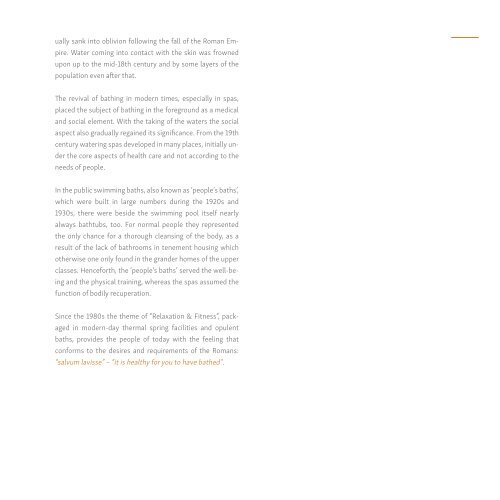Sie wollen auch ein ePaper? Erhöhen Sie die Reichweite Ihrer Titel.
YUMPU macht aus Druck-PDFs automatisch weboptimierte ePaper, die Google liebt.
ually sank into oblivion following the fall of the Roman Empire.<br />
Water coming into contact with the skin was frowned<br />
upon up to the mid-18th century and by some layers of the<br />
population even after that.<br />
The revival of bathing in modern times, especially in spas,<br />
placed the subject of bathing in the foreground as a medical<br />
and social element. With the taking of the waters the social<br />
aspect also gradually regained its significance. From the 19th<br />
century watering spas developed in many places, initially under<br />
the core aspects of health care and not according to the<br />
needs of people.<br />
In the public swimming baths, also known as ‘people’s baths’,<br />
which were built in large numbers during the 1920s and<br />
1930s, there were beside the swimming pool itself nearly<br />
always bathtubs, too. For normal people they represented<br />
the only chance for a thorough cleansing of the body, as a<br />
result of the lack of bathrooms in tenement housing which<br />
otherwise one only found in the grander homes of the upper<br />
classes. Henceforth, the ‘people’s baths’ served the well-being<br />
and the physical training, whereas the spas assumed the<br />
function of bodily recuperation.<br />
Since the 1980s the theme of “Relaxation & Fitness”, packaged<br />
in modern-day thermal spring facilities and opulent<br />
baths, provides the people of today with the feeling that<br />
conforms to the desires and requirements of the Romans:<br />
“salvum lavisse” – “it is healthy for you to have bathed”.




